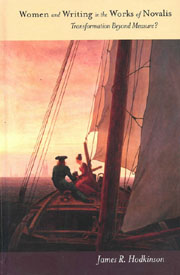Book contents
- Frontmatter
- Contents
- Acknowledgments
- Abbreviations of Major Primary Works Cited
- Typological Conventions in Novalis: Schriften
- Introduction
- 1 Writing in Context: Romanticism, Gender, and the Case of Novalis
- 2 Writing about Women, 1795–99
- 3 Esteem and the Epistolary: Hardenberg and Women of Letters
- 4 Music and the Manifold of Voices: The Subject and the Theory of Polyphony, 1797–99
- 5 From Music to Metamorphosis: Women's Role and Writing in Heinrich von Ofterdingen, 1798–1801
- 6 “Freyes Fabelthum”: The Poetic Construction of Gender in Hardenberg's Religious Writing
- Conclusion: Progression, Reaction, and Tension in Hardenberg's Gender Writing
- Works Consulted
- Index
5 - From Music to Metamorphosis: Women's Role and Writing in Heinrich von Ofterdingen, 1798–1801
Published online by Cambridge University Press: 05 February 2013
- Frontmatter
- Contents
- Acknowledgments
- Abbreviations of Major Primary Works Cited
- Typological Conventions in Novalis: Schriften
- Introduction
- 1 Writing in Context: Romanticism, Gender, and the Case of Novalis
- 2 Writing about Women, 1795–99
- 3 Esteem and the Epistolary: Hardenberg and Women of Letters
- 4 Music and the Manifold of Voices: The Subject and the Theory of Polyphony, 1797–99
- 5 From Music to Metamorphosis: Women's Role and Writing in Heinrich von Ofterdingen, 1798–1801
- 6 “Freyes Fabelthum”: The Poetic Construction of Gender in Hardenberg's Religious Writing
- Conclusion: Progression, Reaction, and Tension in Hardenberg's Gender Writing
- Works Consulted
- Index
Summary
LIKE THE LEHRLINGE, OFTERDINGEN was incomplete when Hardenberg died. Posterity was left with the novel's apparently complete first half, an incomplete second half, a declaration of the intent to rewrite both, reported at second hand, and a score of drafts, jottings, and plans for its continuation. Begun toward the end of November 1799, the novel was continued in two main bursts during 1800, initially through the year's first quarter with the first half finished in early April, then again over the summer months between July and September. During the latter half of 1800, Hardenberg's tuberculosis developed apace; by January 1801 his condition had deteriorated considerably and he returned to Weißenfels to be nursed at home. Remarkably, at this time, he was full of hope for the future. Though he could write little he continued reading and thinking, made plans for the novel's continuation and even, according to Fr. Schlegel, began to plan for its complete alteration (N I, 187). What such changes might have entailed is almost entirely a matter of speculation, and contemporary scholars can only continue to work with the texts at their disposal. In the following, then, we will begin to consider ways and means of reading what we have of the novel in terms of the model of interpersonal and “musical” polyphony discussed in the last chapter. This will involve not only examining of the novel's main torso but also scouring the notes for its continuation (Paralipomena), for evidence that the text might have developed “polyphonic” characteristics.
- Type
- Chapter
- Information
- Women and Writing in the Works of NovalisTransformation beyond Measure?, pp. 168 - 243Publisher: Boydell & BrewerPrint publication year: 2007



